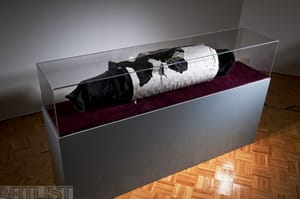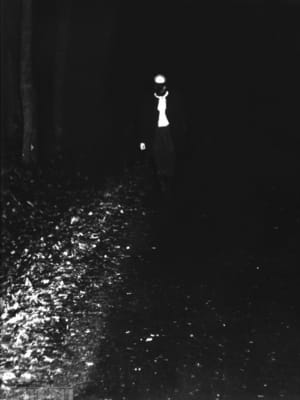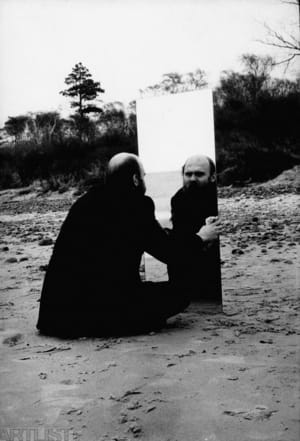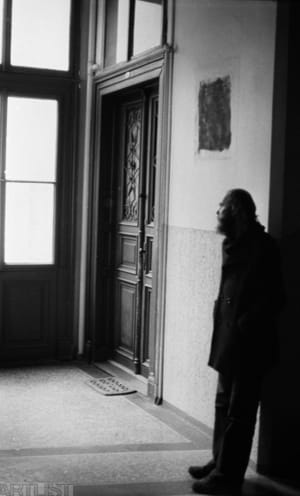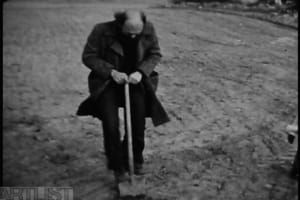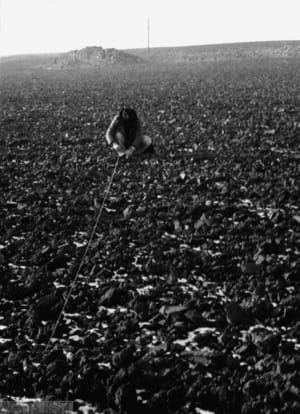- First Name
- Lumír
- Surname
- Hladík
- Born
- 1952
- Birth place
- Český Brod
- Place of work
- Toronto, Canada
- Website
- www.lumir.ca
- CSU Library
- ↳ Find in the catalogue
About artist
Lumir Hladík’s typical action art can be described as some sort of a “derailed” situation. Despite utilizing his body as a tool during his performances, the body, however, is not thesubject of his work. His actions cannot be classified as “traditional” body art. Rather, they bear resemblance to a physical demonstration of a thought construct or process. It isoften a subtle shift of an ordinary situation that Hladík exploits in order to expose reality as we experience it and that strikes in like a lightning out of a blue sky.
Hladík’s action art has started to develop in the mid 70’s, originating in the background of a political “normalization process”, with which, especially from today’s perspective, itstrongly resonates, despite the fact that it was originally not connected to politicalcircumstances and that it was being performed in extreme secrecy. Hladík was loosely associated with Prague’s body art triage (Petr Štembera,Karel Miler,Jan Mlčoch) and was cultivating an intense friendship with Jiří Kovanda. Some of Hladík’s early action pieces were performed in his native Český Brod and its vicinity. In his action piece “ Innocent paper, innocent people! (1976), Hladik laid a sheet of white wrapping paper on the sidewalk in front of a shop he singled out for this event. Passersby had to decide howto deal with this “impediment”; whether to jump over it, walk around it or step on it. Hladík documented this action piece. It is evident from many of the photographs thatpeople of the Czechoslovakia’s “normalization” era tried to avoid this obstacle at all costby stepping into the street, lifting up and carrying baby carriages or jumping over it.
Subsequent performances of the artist took place predominantly outdoors; here, heinvestigated the connotations of tactile space-time and its attributes, where, via physicalaction-interventions he had made visible what would have otherwise remained un-noticed or conversely he developed new mysteries and obscurities. Similar concept is driving Hladík’s action piece “Nobody will disturb my circles! (1976). Hladík has run, with only a photographer present, two large circles in a stubble field near his native town. Hisobjective was to run two circles large enough to prevent any possibility to observe if they had intersected. On many occasions, the sole purpose of Hladík’s oeuvre was the creation of “non-knowledge, which he defines as a form of newly acquired experience. Many ofhis action art’s themes revolve around human relationship with existence and space, for example his “My personal “eternal” vector” (1977), “Boundary; a question withoutanswers” (1977), “I reduced the diameter of Earth” (1977) or “The vanishing row”, which he performed with the assistance of Jiří Kovanda on a field near Český Brod.
In 1977 Hladík began to perform in urban environment; a good example would be “ I amnot finishing the run around St. Vitus Cathedral” (1977). St. Vitus, Prague’s most famouscathedral, with its thousand-year history and symbolic legacy, was an appropriate trigger for a conceptual demonstration; Hladík has touched one of its exterior pillars with the tip of his shoe and began to run around it. He did not, however, complete a full circle; hestopped near the initial exit point (a pillar) and measured the remaining distance – it was14 cm. Other performances that have taken place in Prague; “Anonymous doors” (1980) and Silence and hunger (1980), were addressing, according to the artist, the issue of awidespread illusion; 99.9% of humans believe that their visceral world is actually real.
At the end of the seventies, the Prague’s body art movement, in which Lumír Hladík participated (mainly in a role of an observer), began to show a sense of exhaustion. The very nature of action art was undergoing a change: Petr Štembera caesed to perform his tense body actions. Jiří Kovanda, within the framework of evening gatherings with friends, replaced actions with discret installations. Lumír Hladík, however, performed several significant action-art pieces during this very period. Actions, that reflect thecontemplated potential emigration; it actually materialized in 1981. In the art-event titled “Somewhere, Nowhere” (1979), Hladík’s friend drove the artist, blindfolded, for severalhours to an unknown destination. After sitting him down onto a patch of grass, just for afew minutes, he drove him back without ever disclosing the site’s location. Lumír Hladík’s only art-event, which was known in the Czech art community until recently, came from this period – The mirrored Sea (1980). Petr Rezek wrote about it in his iconicbook “Body, object and reality in contemporary art (published in 1982 by the Czech artorganization “Jazz Section”).
Lumír Hladík asked his friends to drive him, blindfolded, to the Baltic Sea. After placing a mirror on a beach and securing it in an upright position, his friends brought himtowards it. Only then, after he had turned his back towards the sea, has Hladík taken away his blindfold and observed the reflection of the seascape in the mirror. Afterwards, he let his friends escort him, blindfolded, to the car and they returned back to Czechoslovakia. This radical art-action raises a number of questions and associations; itreveals an existential yearning for freedom but also hints at the seeming impossibility ofattaining it within the confines of the totalitarian Czechoslovakian regime. Thisperformance has been filmed and the fact that this footage still exists is a uniquephenomenon in the history of Czech Action Art of the 70s. Hladík’s very last art-action before immigrating to Canada is titled “Nowhere (1981). This one was essentially, as well, an attempt to touch the imaginary line between reality and its appearance.
In Canada, Lumír Hladík has immersed himself into drawing, graphic design and theatre.In recent years, he is developing complex projects in which he connects human culture to Canada's most remote wilderness. He entices wild animals to destroy protein-filled objects, which he then, while using various artistic practices, transforms into nearly fetishistic objects in his studio; Symbiotic Baroque (2006-2011). Hladík’s unique bioevents, which include not only the participation of insects and birds, but also wild black bears, become an inaugural phase of a creative process, which combines the artist’sconceptual roots with his admiration for traditional art creation techniques.
- Author of the annotation
- Pavlína Morganová
- Published
- 2011
CV
Studies:
1974-1977 Václav Hollar Higher School of Applied Arts and High School of Fine Arts
Exhibitions
- Solo exhibitions
-
2012
Symbiotic Baroque, Arboreal Gothic, MUSEUM OF NEW, Toronto, Canada
2011
35 let, 6000km, spolu s Jiřím Kovandou, Galerie SVIT, Praha, kurator – Pavlína Morganová
1983
Lumir Hladik, Centre for the Arts, Toronto, Canada
1979
Lumír Hladík a Petr Meřička
Klub Vysoké školy ekonomické, Praha
- Group exhibitions not included in ARTLIST.
-
2012
Samizdat, České Velvyslanectví, Washington, DC, USA
2011
Czech Center Gallery New York, NY, USA
"Volny Čas", Národní Galerie Praha, Česká Republika
2010
Artspin, Toronto, Kanada
Museum of New New Painting, Toronto, Kanada
Beverly Owens Project Gallery, Toronto, Kanada
2009
Beverly Owens Project Gallery, Toronto, Kanada
ARTA gallery, Toronto, Kanada
Peak Gallery, Toronto, Kanada
The Artist Project, Toronto, Kanada
2008
ITCA, Národní Galerie Praha, Česká Republika
1979
Places and Moments, Galeria Foto-Medium-Art, Wroclaw, Polsko
Experience Book, Gallery Maki, Tokyo, Japonsko
1975
Museum v Českém Brodě, Československo
1974
Museum v Českém Brodě, Československo
- Collections
-
Národní Galerie v Praze, Česká Republika
Uměleckoprůmyslové Museum v Praze, Česká Republika
Museum v Českém Brode, Česká Republika
Monography
- Monography
Pavlína Morganová (ed.), Lumír Hladík, Galerií SVIT, Praha, 2011.
ISBN 978-80-260-0383-0
- Articles
Tomáš Pospiszyl - Muž, který svět pozoruje v zrcadle, Lidové noviny, 9. 9. 2011, s. 8.
Jiří Ptáček, Umělec se zavázanýma očima, Nový prostor, 8.10.2011, s. 23.
Silvie Šeborová, Hladík a Kovanda ve SVITu, artalk.cz, 29.10.2011.
Ivan Adamovic - Knížák muže jet trempovat, umělci mají volný čas, aktualne.cz, 3.10.2011.
Róbert Dyda - Torontský filmový festival, svet v zrkadle a podmorské obludy – 5+1, Sietovka, 12. 9. 2011.
Terezie Nekvidová - 35 let 7000 kilometrů. Lumír Hladík a Jiří Kovanda, kulturissimo.cz, 8.09.2011.
Lenka Dolanová - Kilometry Lumíra Hladíka ve Svitu, A2, 02.09.2011.
Karina Kottová - Lumir Hladik a Jiri Kovanda, Galerie SVIT Praha, Flash Art, prosinec 2011 - březen 2012.
- Other critical texts
Petr Rezek, Tělo, věc a skutečnost v současném umění, Praha 2010
Pavlína Morganová, Akční umění (druhé rozšířené vydání), Nakladatelství J. Vacl, Olomouc, 2010.
Petr Rezek, Tělo, věc a skutečnost v současném umění, Jazzová sekce, Praha 1983.
Genevieve Benamou, L'art nouveau en Tchecoslovaquie, 1977.
- Personal texts not included in database
Paradox Taxidermie, in: Volný čas, Národní Galerie v Praze, Praha 2011.

